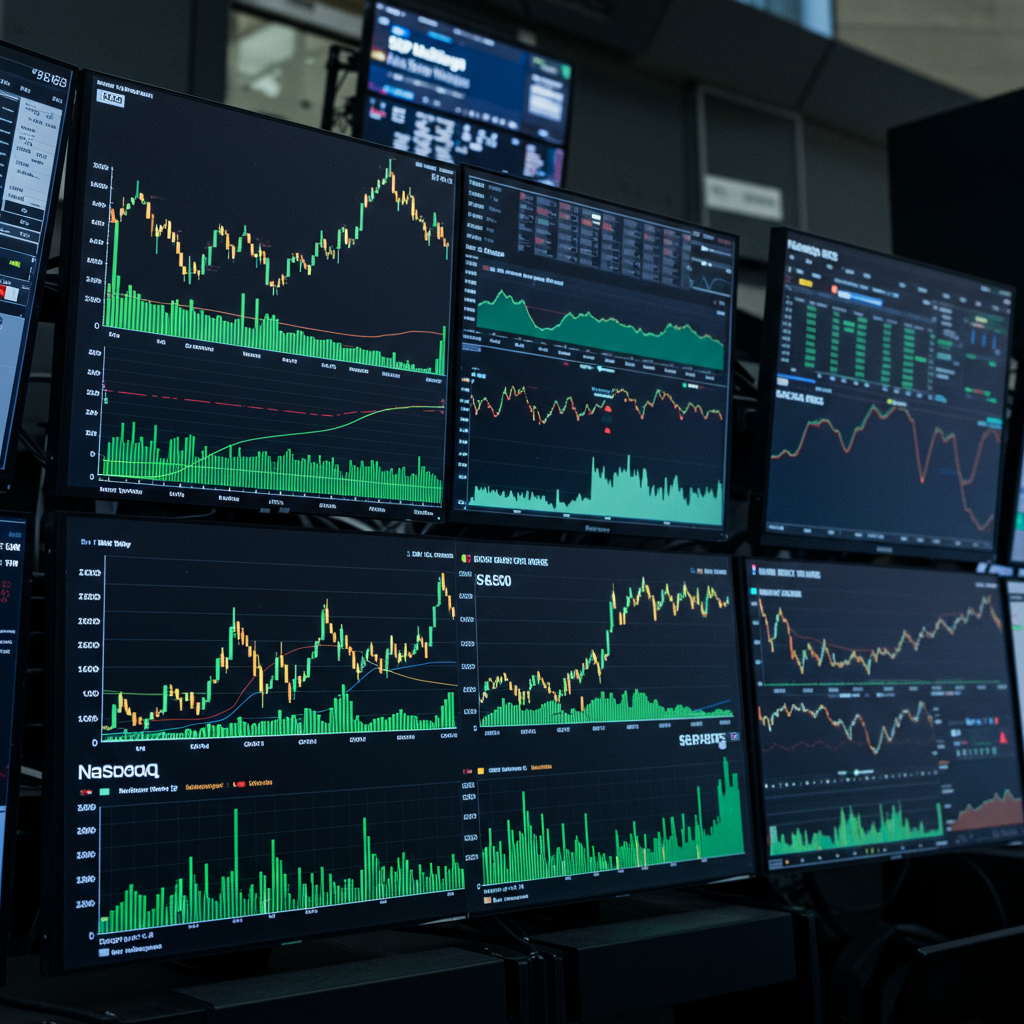The US stock market has achieved a significant milestone, with both the S&P 500 and Nasdaq Composite indices closing at new all-time highs. This remarkable feat on Friday, June 27, 2025, signals the full recovery from a steep downturn just months prior. It underscores a dramatic shift in investor sentiment and market dynamics. The journey from near bear market territory in early April to record levels just 80 days later highlights an incredible, rapid turnaround on Wall Street.
Record Highs Across Major Indices
Friday, June 27, 2025, marked the first time the S&P 500 index closed at a new record since February 19. It gained 0.5% on the day, reaching an unprecedented closing level of 6,173.07. This surpasses its previous all-time peak set months earlier.
The Nasdaq Composite index also notched its own record high on the same day. Gaining 0.5%, this was the Nasdaq’s first record close since December 16. Known for its heavy weighting in technology stocks, the Nasdaq has been a key beneficiary of recent trends. The smaller Nasdaq 100, comprising the largest tech companies, had already set its own record earlier in the week, reflecting the sector’s strength.
While not hitting its own all-time record on Friday, the Dow Jones Industrial Average also saw substantial gains. The blue-chip index rose 432 points, a 1% increase. Despite this strong showing, the Dow remained about 2.7% below its historical peak. Underperformers like UnitedHealth, Apple, Merck, and Nike contributed to it trailing the S&P 500 and Nasdaq. Importantly, all three major indices recorded their largest weekly gains in six weeks, signaling broad market momentum.
The Stunning Rebound Story
Just over two months before hitting record highs, the stock market faced significant challenges. In early April, specifically around April 8, the S&P 500 was hovering near bear market territory. It had shed a staggering $9.8 trillion in market value from its February 19 peak to its April 8 low.
Few experts on Wall Street predicted such a swift recovery. The market had seemingly completed a “wild round trip,” regaining all lost value within approximately 80 days. This rapid snapback surprised many, demonstrating the market’s resilience and ability to quickly adapt to changing conditions.
The downturn itself was largely attributed to escalating trade tensions. Historic tariffs imposed by the Trump administration created significant uncertainty. Measures described as “Liberation Day” on April 2 saw tariffs surge dramatically. Some tariffs on China even climbed over 145% for certain products, effectively creating a trade barrier. This “completely manufactured crisis,” as one strategist called it, alarmed investors and economists who feared it could trigger inflation and recession.
However, the market turnaround began shortly after the April 8 low. On April 9, the administration paused “reciprocal” tariffs for 90 days, a move seen as a direct response to negative market signals from stocks, currency, and Treasury markets. This pause provided immediate relief, triggering a market surge.
Catalysts Fueling the Climb
Several factors converged to propel the market rebound and push indices to new records. Easing trade tensions played a pivotal role. The 90-day tariff pause was followed by more positive developments. Framework trade deals were reached with the United Kingdom and China in the month leading up to the record highs.
On the specific Friday the records were hit, news from China signaling the reopening of its rare earth market to the US further boosted sentiment. Despite significant tariffs remaining in place (including a 10% universal tariff, 50% on steel/aluminum, and 25% on autos/parts), markets increasingly looked past trade worries. Treasury Secretary Scott Bessent expressed optimism that trade negotiations with 10 to 12 of 18 key partners could be finalized by Labor Day. This offered a more relaxed timeline than the original July 9 deadline associated with the potential return of reciprocal tariffs.
Beyond trade, the boom in Artificial Intelligence (AI) emerged as a primary catalyst. Fueled by surging demand for chips from companies like Nvidia and supported by deregulation efforts, the AI trend heavily boosted technology stocks. Given the Nasdaq’s composition, this tech rally was a major driver of its record performance.
Hopes for interest rate cuts from the Federal Reserve also provided tailwinds. Supported by relatively strong economic data and low inflation figures (May inflation registered 2.3% overall, 2.7% core year-over-year), expectations of lower borrowing costs boosted investor confidence. Surprisingly strong demand for Treasury bonds further underlined investor confidence in the US economy and its debt stability, despite recent concerns following a House-passed domestic policy bill that touched on the debt ceiling.
Market sentiment also adapted to unpredictable political communications. Investors learned to process news and tweets, even those causing temporary dips, with a “massive grain of salt.”
Investor Behavior and Market Unpredictability
The market’s recent behavior highlights interesting dynamics in investor psychology and positioning. Retail investors were notably active during the downturn, largely “unfazed” by volatility. They were seen as key drivers buying the dip, demonstrating resilience and a willingness to chase gains.
In contrast, many professional money managers initially held back, described as “exhausted” by volatility and finding the market environment challenging. They had significantly reduced exposure, leading to “cut-to-the-bone positioning.” However, as the rally persisted and cash accumulated on the sidelines, professionals faced increasing pressure to re-enter the market. Factors like lifted bearish hedges, buying signals from systematic trend-following funds (though still cautiously positioned), persistent retail momentum, and falling market volatility metrics began to compel institutional buying.
Despite the upward momentum, a sense of caution persists among many fund managers. Concerns about slowing economic growth, the continued unpredictability of trade policies influenced by presidential announcements, and uncertainty surrounding the timing and pace of future Federal Reserve rate cuts remain significant sources of worry. Even commodity trend advisors, while increasing equity exposure slightly, remain conservative compared to historical levels. Technical levels on indices like the S&P 500 (around 5,800-6,000) were watched as potential hurdles or catalysts for further systematic buying.
While the majority celebrated the record closes, dissenting views remain. Some analysts expressed concern about “a dangerous amount of complacency” regarding trade issues, noting that markets might be overreacting to positive headlines or celebrating the same news multiple times. Some bearish positions were recommended in riskier sectors like small caps, citing weak market internals despite the headline gains. The market environment is seen as highly sensitive to sudden shifts based on news or tweets, making navigation challenging even at record highs.
A brief moment of drama on Friday afternoon underscored this sensitivity. Stocks temporarily turned negative after President Trump announced the US was ending trade talks with Canada over a new digital services tax and planned new tariffs. However, the market quickly rebounded within an hour, resuming its climb to the close.
Challenges on the Horizon
Despite the recent surge to record highs, the market is not without potential pitfalls. Several significant challenges loom in the coming weeks and months.
One key domestic risk is the possibility of a stalemate in Congress over the domestic policy bill. This legislation includes a provision to raise the debt ceiling. Failure to raise the debt limit could bring the US dangerously close to defaulting on its debt obligations, a scenario that would severely disrupt markets.
Another major concern relates back to trade policy. The 90-day reciprocal tariff pause is set to expire on July 9. If further comprehensive trade deals are not secured by then, tariffs could potentially increase again. This would reignite fears about trade’s impact on the economy.
Geopolitical risks, while perhaps less prominent in recent headlines, also remain. The prospect of conflict in the Middle East, for instance, continues to be a concern despite recent fragile truces.
Existing tariffs, even if not escalated further, still pose risks. They have the potential to contribute to rising prices in the coming months. Increased inflation could hurt consumer spending and economic growth overall.
Beyond these macro risks, the market faces concerns about valuations. The rapid rally has pushed stock prices significantly higher relative to expected corporate profits. The S&P 500’s price-to-earnings (P/E) ratio has reportedly surged past 23. This level is considered relatively high, indicating that stocks have become quite expensive compared to their earnings potential. High valuations can make the market more susceptible to sharp pullbacks if earnings expectations falter or negative news emerges.
While the close on Friday saw palpable celebration on Wall Street, the path ahead is marked by uncertainty. The factors that fueled the rally face tests from political, economic, and geopolitical headwinds.
Frequently Asked Questions
What primarily drove the rapid stock market recovery from its April lows?
The swift rebound from near bear market levels in April to record highs in June was fueled by several key factors. A major driver was the easing of trade tensions, particularly the pause in reciprocal tariffs by the Trump administration and progress on new trade frameworks. The booming Artificial Intelligence (AI) trend significantly boosted technology stocks, which heavily influence indices like the Nasdaq. Hopes for potential interest rate cuts from the Federal Reserve, supported by stable economic data, also lifted investor sentiment. Retail investors actively buying during the dip also played a notable role.
Given the recent record highs, should investors be concerned about current market valuations?
Yes, the rapid ascent has led to concerns about valuations. The S&P 500’s price-to-earnings (P/E) ratio has climbed significantly, reportedly above 23, indicating stocks are expensive relative to expected profits. While high valuations don’t guarantee a downturn, they suggest that the market may be more sensitive to negative news or disappointing earnings reports. This is considered a potential “less existential” threat compared to macro risks, but still a significant challenge to consider for the market’s sustainability.
How did the trade war under the Trump administration impact the market rally, and what is the current outlook?
The trade war significantly impacted the market rally by initially causing sharp sell-offs and contributing to the April low point. Tariffs imposed by the administration were described as a “manufactured crisis” that created fear and uncertainty. The market began to recover notably after the administration paused some tariffs and later reached framework deals with key trading partners. While some tariffs remain, investors have largely looked past these issues recently, focusing on other catalysts. However, the potential expiration of the 90-day tariff pause on July 9 poses a risk of tariffs increasing again if more deals aren’t secured, which remains a challenge on the horizon.
In conclusion, the US stock market’s climb back to record highs represents a dramatic and rapid recovery driven by easing trade tensions, the AI boom, and hopes for favorable monetary policy. While the achievement is significant, the path forward is not without challenges, including potential political stalemates, lingering tariff risks, geopolitical concerns, and elevated valuations. The sustainability of the rally will depend on navigating these complex headwinds.
Word Count Check: 1170 words




